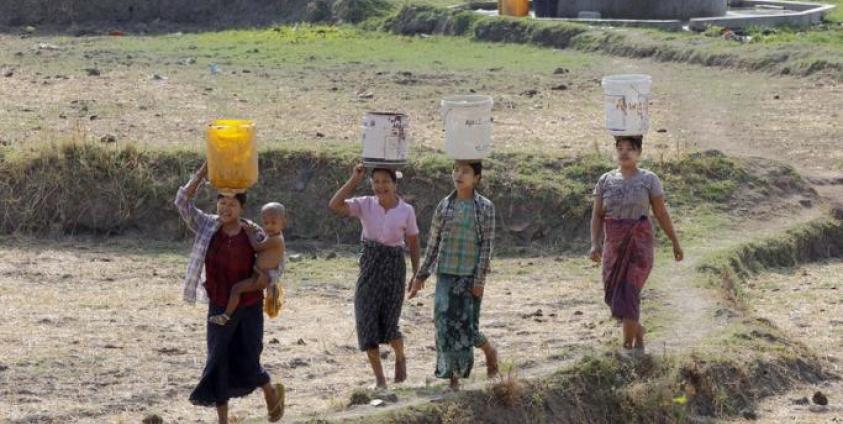"We live in a part of the world that will be hit incredibly hard by climate change. The disruptions to agriculture and food security will be enormous. People will simply not be able to live as they are, where they are"
Thant Myint U, 2018
“Climate Change” and “Migrations” are two international growing issues discussed everywhere but too rarely related to each other. From Myanmar’s perspective, not only as an agriculture-based country but also as one of the most vulnerable countries to climate change, “Climate Change” and “Migrations” are strongly related to each other.
According to the World Bank, “by 2050 climate change could force more than 143 million people to move within their countries.” This includes 40 million people in South Asia neighboring Myanmar. At present, human beings are already fleeing dry zones turning into desert, river-delta being stroke by heavy monsoon and tropical cyclone. People are forced to escape the effects of climate change and the future only seems to get worst. Myanmar is no exception.
Temperatures in Myanmar are expected to rise by 1.3°C to 2.7°C by 2050, sea-level is expected to rise between 20 to 40cm by 2050. According to Myanmar Climate Change Alliance, Myanmar will face more and more natural disasters including droughts, more frequent extreme storms, changes of the monsoon climate, heavy rains, floods, extreme heat, the rise of sea level and infiltration of sea water into lands. Moreover, incautious behaviors from the past such as extreme logging and overuse of chemical fertilizers affect landslides and the destruction of agricultural lands, these endangers the future or hundreds of thousands of people in Myanmar. Farmers in the dry-zone, and paddy-field holder in the Ayeyarwady delta are likely to be forced to move and migrate.
I remember the words of my grandfather for about 20 years ago. If it was raining the whole day or more than one day, my grandfather would gaze the rain and say that the poor will cry due to those rains and how day-laborers struggle for their living. The most vulnerable are the first affected by the impacts of climate change. It is natural for human beings to migrate to places which can offer better living conditions. Nomadism is a behavior of human beings since ancient times. When it becomes more and more difficult for people to do their daily agricultural works, inevitably they are to migrate to places that can offer better livelihood opportunities.
In 2015, there were already 9 million internal migrants in Myanmar coming mostly from the Dry-zone and Ayeyarwady region. Destination of those current growing migrations are currently big cities such as Yangon and Mandalay. 800,000 migrants arrived in Yangon between 2009 and 2014, most of them settling in peripheral township, Hlaing Thar Yar, Dagon Seikkan and Mingalar Don industrial zones. Migrants can work for their living, can search for their clothing but it is very difficult for them to look for housing because of land price and legal-tenure issues. That’s what led to the development of “informal settlement” in Yangon and Mandalay. UN-Habitat in 2017 estimated informal settlements population in Yangon around 350,000 people, this population is constantly growing. More than half of those informal settlements were built after 2008 following climate change related Cyclone Nargis. Wherein 40% of those informal settlements are located in Hlaing Tharyar township, already housing a population of 700,000 (comparable to Chin and Kayah States), with newcomers every day. This expected growth in informal settlement is driven by climate change consequences. And this is just the beginning.
It is key to relate that those migrations are valuable to the industrial sector as they are an important source of labour and inputs. In building industrial zones and cities, large labor force is a resource for developers. Therefore, internal migrants, economic zones and cities are should be seen as interactive. If handled properly -by providing services to newcomers such as electricity, water, public lighting and medical facilities- migrations could turn into opportunity.
I highlighted that Myanmar’s internal migrations are heavily driven by the effects of climate change. Being one of the most vulnerable countries in the world to climate change, Myanmar is going to face much more internal and external migration in the very near future. How to allocate those migrant population is a real pressing challenge for the present and future political actors who are responsible for urban planning.
Comprehensive solutions should not only focus on short-term issues such as providing basic services to informal settlements but also tackle the roots causes of migration in the country. Stopping deforestation, designing new agricultural practices, investment in renewable energy, preventing economic inequalities, are all key solutions for this long-lasting migration issue.
As the prominent scholar U Tun Lwin taught us, climate change is transforming our societies. If both pollution sources and economic inequalities are not addressed, then environmental change will nurture internal tensions and social conflicts. Climate migrations are an urging problem for state holders and political actors building the future of Myanmar.
Courtesy of:
Ms Ei Khin Khin, Myanmar Representative (Green Lotus), Activity Manager (Bawapanding Project, Capacity Development for Informal Settlement in Dagon Seikkan Township)
Mr Thibaut Bara, Monitoring and Evaluation Officer, Activity Manager (Bawapanding Project, Capacity Development for Informal Settlement in Dagon Seikkan Township)








